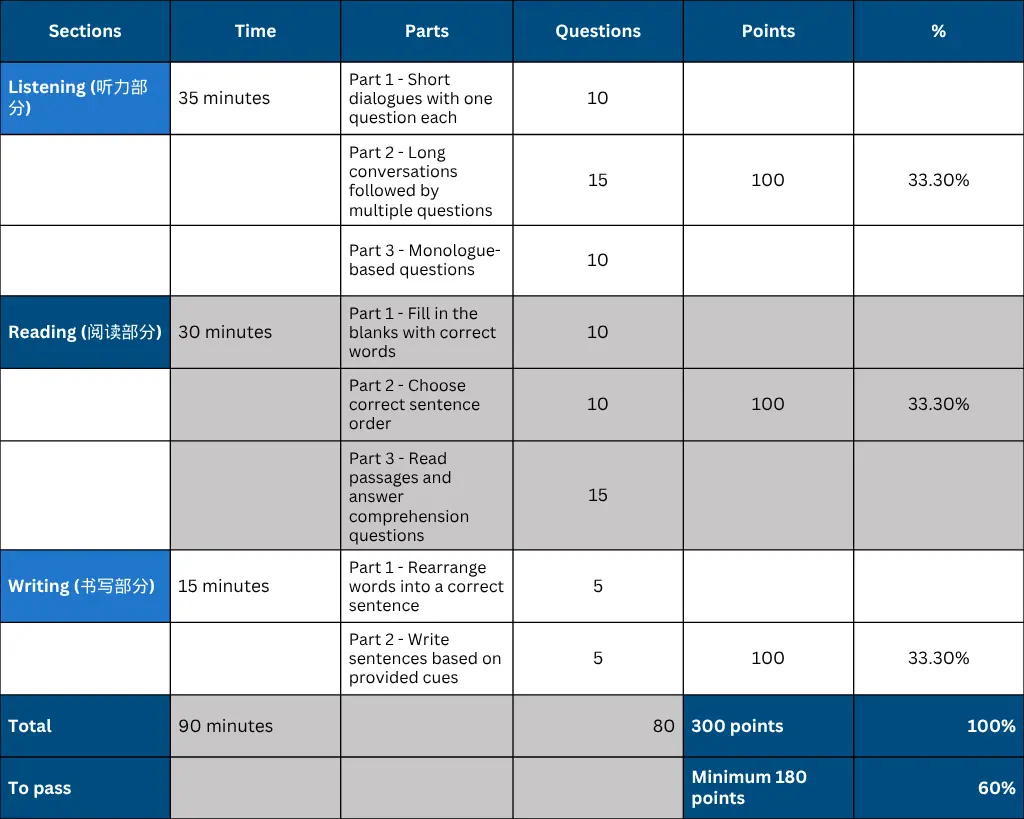The HSK 4 test is a significant milestone in the Chinese language proficiency system, designed for learners moving toward fluency in Mandarin. As part of the broader Chinese exam framework known as the Hànyǔ Shuǐpíng Kǎoshì, it measures your ability to use Chinese in real-world settings. This exam goes beyond basic conversations, assessing your skills in reading, writing, and listening with precision. Whether for academic purposes, career growth, or personal goals, preparing for this level shows a strong commitment to mastering the language.
Exam Structure

The HSK 4 test measures proficiency in handling daily conversations and written texts using around 1,200–2,400 words from the hsk 4 vocabulary list. Familiarity with the structure and continuous practice using official hsk 4 vocabulary is essential for successfully passing the HSK 4 test.
Exam Eligibility Criteria
The HSK 4 test is designed for learners who have built a solid foundation in Chinese and wish to improve their ability to engage in everyday and professional conversations. It evaluates competence in reading, listening, and writing using more complex structures and approximately 1,200–2,400 vocabulary words.
- Best for International Learners: The test targets non-native speakers who wish to use Chinese in both personal and professional settings. Practicing with a sample HSK 4 test paper helps bridge gaps in comprehension and increases confidence in dealing with real-life conversations and written tasks.
- Minimum Age Recommendation: Although there is no formal age requirement, the HSK 4 test is best suited for learners aged 15 and above. The test involves nuanced sentence patterns and topic-specific vocabulary that align with real-world scenarios such as workplace discussions and academic dialogues.
- Language Proficiency Requirement: Candidates should have a strong grasp of HSK Level 3 material and be comfortable using intermediate grammar and vocabulary in context. Reviewing an HSK 4 test paper before attempting the exam can help reinforce sentence construction, word usage, and logical flow.
- No Academic Restrictions: The exam is open to all learners regardless of their formal education or location. Anyone studying Chinese as a second language—through school, online courses, or independent study—is eligible to take the HSK 4 test.
Exam Pattern – Detailed Structure
The HSK 4 test evaluates your Mandarin proficiency through Listening, Reading, and Writing sections using intermediate grammar and vocabulary from a 1,200–2,400 word list. Practicing with a Hsk 4 test sample can help you understand the structure and pacing of the exam.
Listening (听力) – ~35 minutes | 3 parts | 45 questions
Part 1: Listen to 10 short dialogues, each played once. After each, answer one multiple-choice question. Tests understanding of simple conversations and everyday topics.
Part 2: Listen to 15 longer dialogues, each with one question. Dialogues are slightly more detailed and context-based. Focus on key info like time, reason, or opinion.
Part 3: Listen to short passages or monologues, followed by 20 questions. Played once only. Requires attention to overall meaning, logic, and details.
Reading (阅读) – ~40 minutes | 3 parts | 40 questions
Part 1: Complete 10 sentences by choosing the correct word or phrase from three options. Tests grammar, vocabulary, and logical flow.
Part 2: Match sentence pairs or connect phrases in the right order (10 questions). Requires knowledge of sentence structure and linking ideas.
Part 3: Read 3–4 short passages and answer 20 comprehension questions. Tests understanding of facts, opinions, and implied meaning.
Writing (书写) – ~25 minutes | 2 parts | 15 questions
Part 1: Rearrange 10 jumbled sentences into correct word order. Tests grammar, syntax, and word placement.
Part 2: Write a short paragraph (about 80 characters) using a picture + 3 given words.Tests ability to create meaningful, coherent sentences based on a prompt.
The HSK 4 test follows a clear structure, and reviewing a Hsk 4 test sample helps build familiarity with common task types and improve confidence.
Passing Criteria
Learners preparing for the HSK 4 test often seek clarity on how the exam is evaluated and what score qualifies as a pass. It assesses listening, reading, and writing skills using content drawn from the HSK 4 vocabulary list. Practicing with an HSK 4 test paper builds familiarity with question formats and language usage.
- Score Breakdown: The exam is scored out of 300 points, with Listening, Reading, and Writing sections contributing 100 points each. This equal weight ensures balanced evaluation based on the official HSK 4 vocabulary and grammar standards.
- Passing Requirement: A minimum overall score of 180 is required to pass the test. Individual section scores are not isolated, meaning stronger performance in one area can make up for lower results in another.
- Evaluation Method: All answers are machine-graded for fairness and consistency. Working through an HSK 4 test paper can help candidates become comfortable with sentence structure, logic, and expected responses.
- Result Format: Your result will be marked as “Passed” or “Not Passed”. You will also receive a detailed score report showing your individual scores in Listening, Reading, and Writing. This breakdown helps you clearly understand your strengths and areas that need improvement.
- No Sectional Cut-off: There is no requirement to pass each section separately. As long as your total score is 180 or above out of 300, you pass—even if one section has a lower score. This flexible scoring system makes the HSK Level 4 exam more achievable for learners focusing on real-world communication skills.
Conclusion
The HSK 4 test serves as a vital step for learners aiming to achieve fluency in Mandarin, especially in academic and professional settings. It tests a well-rounded grasp of listening, reading, and writing, all based on real-world language use. Consistent practice and review of official materials will enhance your confidence and accuracy. Start preparing early and challenge yourself with full HSK 4 test simulations to ensure success.
Read also: Chinese HSK Level 3